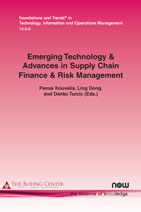A Framework of Hedging Decisions for Supply Chain Partners
By Panos Kouvelis, Washington University in St. Louis, USA, kouvelis@wustl.edu | Xiaole Wu, Fudan University, China, wuxiaole@fudan.edu.cn | Yixuan Xiao, City University of Hong Kong, Hong Kong, yixuxiao@cityu.edu.hk
Abstract
We study cash flow risk hedging in a bilateral supply chain of a supplier and a manufacturer that use internal cash to invest in production efficiency improvements. The associated production efficiency function is convex in capital investment. We offer a conceptual framework for understanding supply chain cash hedging strategies by decomposing the difference of a firm’s expected profit of hedging versus not hedging into a sum of two terms: the cost reduction effect and the flexibility effect of hedging. We find that the correlation of cash flow risks of supply chain partners significantly affects the hedging decisions of firms via impacts on production efficiencies. When the cash flows of firms are independent, the cost reduction effect favors hedging, whereas the flexibility effect favors not hedging. A firm is more likely to hedge when the supply chain is more profitable or its supply chain partner hedges. When the cash flows of firms are correlated, the cost reduction and flexibility effect of hedging may complement each other and support the same hedging choice. The impact of market size on firms’ hedging decisions is contingent on the cash flow correlation.
Emerging Technology & Advances in Supply Chain Finance & Risk Management
Emerging Technology & Advances in Supply Chain Finance & Risk Management reflects the state-of-the-art in research thought leadership in supply chain finance and risk management, and it contains great expository pieces on how advanced technologies are shaping supply chains and risk management within them. You will also find ideas on how supply chain finance and risk management can be best taught in our classrooms.
The volume is divided into three parts, each part reflecting a major active research area of the field including: Part 1: Supply Chain Finance; Part 2: Financial Hedging and Commodity Risks; Part 3: Operational Strategies and Risk Management.
Part 1 deals with the broad area of supply chain finance and programs that will better allow for working capital management within supply chains. Part 2 introduces concepts of hedging financial and operational risks due to uncertain commodity prices, fluctuating exchange rates, and volatile interest rates. Emphasis is placed on understanding how financial hedges can be used for hedging relevant supply chain risks in a way that reflects modern view of financial risk management. Part 3 examines topics and solution approaches reflecting the more traditional treatments in the contemporary literature of operational and supply chain risks. This volume provides rich implications for future research directions in efforts to master the new complexities and uncertainties of the global business environment and better understand the impact of advanced technologies in global supply chains.

Companion
Foundations and Trends® in Technology, Information and Operations Management, Volume 12, Issue 2-3 Special Issue: Emerging Technology & Advances in Supply Chain Finance & Risk Management
See the other articles that are also part of this special issue.